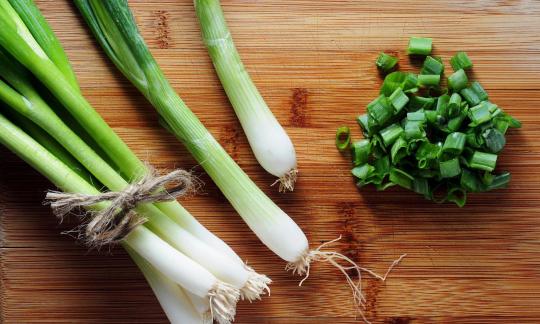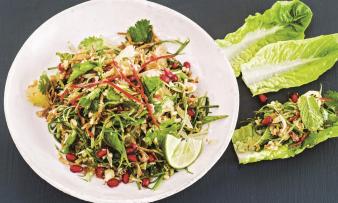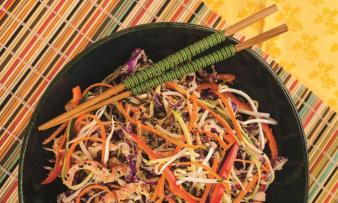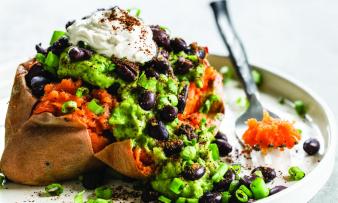Table of contents
Raw winter onions ( Allium fistulosum ) are also called spring onions or scallions . The most important difference to kitchen onions is that they do not form round, thick bulbs, but rather a cylindrical base. Often available in organic quality.
Use in the kitchen
Onion varieties of the species Allium fistulosum are reminiscent of leeks ( Allium ampeloprasum ) because, unlike white onions , red onions and shallots ( Allium cepa ), they do not have any distinct bulbs. 1,3 This is why they are also called spring onions. The name winter onion is ambiguous - here it refers to the vegetable of the species Allium fistulosum (for more information, see: Possible confusion).
Can you eat spring onions (scallions) raw? and Are the onion stems edible? are common questions. With spring or winter onions, you can eat the entire plant raw or cooked. The onion greens are also edible. The green stalks (or stalks = leaves) taste like chives or young leeks and can be used in a similar way. Depending on the variety and age, they have a pleasant spiciness. The cylindrical storage organs are white and taste delicate (milder than bulb onions). When you cut them, your eyes hardly start to water.
In Asian cuisine , the stems and leaves of spring onions are particularly popular in cooked dishes. However, you should be careful not to fry or cook the stalks too hot, otherwise they will lose their flavor. The leaves are suitable raw for salads or soups, as a topping on bread, and for vegan spreads and dips.
Winter onions do not need to be peeled. Simply rinse them well with water to remove any dirt or soil.
Depending on the use, there are different cutting techniques. Long strips are ideal for vegan soups and salads. Diagonally cut, the 2-3 cm pieces can be prepared in a pan with other vegetables, tofu , etc. Finely chopped, spring onions go well with wholegrain rice or quinoa - also as a substitute for onions, leeks or chives. The long base is cut thinner than the rest of the plant. Its fine, spring-like taste goes particularly well with raw dishes.
You can also use the seeds of the winter onion. You can store them dried in a spice grinder and sprinkle them over the dish just before eating. However, as their aroma is very volatile, they must be stored away from light.
Recipe for Asian celery salad with spring onions
Ingredients (for 2 servings): ½ to 1 raw celery root (depending on size), 2 spring onions (organic), 10 g fresh organic ginger (finely diced), 1 red chili pepper in fine rings, 1-2 tbsp soy sauce , 2 tbsp lime juice , 1 tbsp honey , 1-3 tbsp rapeseed oil , 1 tbsp sesame oil (if needed).
Preparation : First peel the celery and cook in boiling salted water until soft, then let it cool and cut into thin slices. Pour 100 ml of the cooking water into a bowl and season with the spices, soy sauce, lime juice and honey. Put the celery slices in the spice broth and leave to steep for about 30 minutes. Just before serving, drizzle with oil and mix in the finely chopped spring onions. Now you can enjoy the vegan salad.
Vegan recipes with winter onions (spring onions) can be found under the note: " Recipes that have the most of this ingredient ".
| Not only vegans or vegetarians should read this: Vegans often eat unhealthily. Avoidable nutritional mistakes . |
Purchasing - Storage
At supermarket chains such as Coop , Migros , Denner , Volg , Spar , Aldi , Lidl , Rewe , Edeka , Hofer , Billa etc., but also at organic supermarkets ( Denn's Biomarkt , Alnatura ), winter and spring onions can be bought in bunches almost all year round . It can happen that the naming is inaccurate or the vegetables are simply labelled as bunched onions: For a real spring onion (leek onion), make sure that it has not developed into a real (round) bulb (see possible confusion). 1,3
When buying, make sure that all the green parts are still plump and that the tubes and tubers do not have any open cut surfaces.
The availability of raw spring onions (winter onions) varies depending on the size of the store, catchment area, etc. Our recorded food prices for the DA-CH countries can be found above under the ingredient image - and by clicking you can see their development at various suppliers.
Found in the wild
The winter onion does not grow in the wild in Germany. Wild ancestors of the species Allium fistulosum can be found in Siberia, including at Lake Baikal (this is A. altaicum ). 1
Storage tips
How do you store spring onions? It's best to keep them in the fridge and use them quickly. The shelf life of spring onions is very limited. The green parts will last in the vegetable drawer for 2-3 days or a little longer. Wrapped in foil, they will stay fresh a little longer, even with the green tubes. If the tubes start to wilt, they should no longer be eaten. They lose their aroma and no longer taste good. After about a week, the bulb can also become woody and the good taste disappears.
Can you freeze spring onions? Yes, you can freeze raw spring onions. To do this, wash the spring onions, drain them and cut them into rings or chop them roughly. It is important to dry them well after washing, as too much water can cause freezer burn: these are dried-out outer layers. To prevent the onion pieces from freezing as lumps, you should spread the cut onions loosely on a plate lined with baking paper and freeze for a few hours. Take the plate out of the freezer, carefully remove the onions from the baking paper and transfer them to a plastic bag or a suitable container. Freeze again immediately so that the pieces do not thaw. After thawing, the onion pieces are hardly suitable as raw food, but their quality is sufficient for cooked dishes.
Ingredients - Nutritional values - Calories
Raw winter onions have a calorie content of 32 kcal/100g. They consist of 90% water and contain 2.6 grams of fiber, 7.3 grams of carbohydrates and a small amount of protein per 100g. They are practically fat-free. 4
Because you eat the green leaves of winter onions, they have a high vitamin K content: 100 g contain 207 µg. Chives have similar values (212 µg) and Brussels sprouts have a little less (177 µg). Swiss chard has a lot of vitamin K at 830 µg/100g. 4 To avoid excessive vitamin loss, green vegetables should always be stored in the dark. Vitamin K is relatively heat-stable, but not light-stable.
Spring onions also provide folic acid : 64 µg/100g is not particularly much when compared to a daily requirement of around 300 µg 9 , but should not be underestimated if consumed regularly. Leeks and green peas provide the same amount of folate. Baby spinach has many times that amount at 194 µg/100g. 4
Potassium is a mineral worth mentioning in spring onions. 100 g provide 276 mg of potassium, which only covers 14% of the daily requirement, but is not bad for a vegetable - and significantly more than in kitchen onions (146 mg). The "potassium-rich" banana , as one often reads, contains only a little more potassium in comparison at 360 mg/100g. Spices and dried herbs contain particularly high levels of potassium. Turmeric , for example, contains 2080 mg/100g, cumin seeds 1788 mg and dried coriander leaves even 4466 mg. Pulses contain around 1000 to 1800 mg of potassium. 4
The complete ingredients of winter onions (spring onions), the coverage of the daily requirement and comparison values with other ingredients can be found in our nutrient tables. In the article Nutrients explained you will get a detailed insight into the topic.
Effects on health
How healthy are spring onions? Like all Allium plants, spring onions have numerous antioxidant ingredients 8 (the stems appear to have the strongest effect 1 ). The green parts of spring onions in particular are considered to be easier to digest, as they contain fewer fructans (FODMAPs) than the white base (and onion bulbs in general). However, in various in vitro studies and in experiments on mice, fructans have shown biological activities against cancer and viruses, 8,20 e.g. flu viruses. A 2012 study confirmed this for extracts from Allium fistulosum . 20 Fructans also have a positive effect on the intestinal flora. 5
The vitamin K in the green part of spring onions is important for proper blood clotting and is involved in bone formation. Vitamin K is also given to newborns to replenish their reserves.
A mixture of spring onions and rice was shown to have immune-stabilizing effects in COVID patients. Research on rats also suggests that Allium fistulosum is effective against arthritis and obesity. 8
Flavonols such as quercetin and kaempferol are well represented in allium plants. They improve blood circulation and prevent blood clots and arteriosclerosis. In addition, onions of all kinds are effective in treating bronchial and asthmatic diseases. They are said to have antibiotic, heart and vascular protective, diuretic and anti-cancer properties. 5 The juice of raw winter onions (but not cooked ones!) led to a reduction in blood pressure in rats and had an antithrombotic effect. 7
For more details on the effects of onions on the human body, see the ingredient onion, raw .
Dangers - Intolerances - Side effects
Although most onions are poisonous or indigestible for humans, kitchen onions and other Allium plants such as winter onions help maintain our health. However, they can be poisonous for other mammals (such as horses, cats, dogs).
Some allergy sufferers may develop contact eczema, in which low-molecular sulphur compounds act as allergens, as in garlic. Sensitive people may react to onion fumes with asthma. 6
Folk medicine - naturopathy
Ethnomedical uses of spring onions are common and widely documented in China, Taiwan, Japan, South Korea and India. Among other things, they are used for flu, various intestinal problems, stomach and headaches, kidney problems, arthritis and heart and circulatory diseases. 8
Ecological footprint - animal welfare
When studying the ecological balance, no distinction is often made between the individual types of onion.
In 2019, the Institute for Energy and Environmental Research Heidelberg ( ifeu ) examined almost 200 foods in Germany for their environmental impact. The calculation of the ecological footprint is based on average values for agricultural production (including all upstream processes, such as fertilizer production), food processing, packaging (including disposal of the same) and distribution to the supermarket. Different cultivation methods (organic - conventional), domestic production vs. import by truck, ship or plane, etc. were also taken into account. For selected foods, the authors also point out the phosphate, water and land consumption. Onions, in general, do very well with a CO 2 footprint of 0.2 kg CO 2 eq/kg . 13
Another positive aspect for the environmental impact of onions is the possibility of outdoor cultivation in the DA-CH region almost all year round if suitable varieties are chosen. 15 The amount of water required to produce 1 kg of onions is on average 272 litres. 14
Spring onions in particular can contain residues of pesticides. 16 Ideally, when buying spring onions, you should therefore choose organically grown ones, as the use of such agents is prohibited there.
Worldwide distribution - cultivation
Researchers assume that spring onions ( Allium fistulosum ) were domesticated near Lake Baikal (in Siberia, near the Altai Mountains in Russia) and in the west or northwest of China. 1 In China, this species was used 2000 years before the Common Era. 5 During the Middle Ages, it came to Europe via Russia. 1
Since the kitchen onion ( Allium cepa ) does not grow so well in tropical climates, the winter onion is preferred there. In Asia, it is often grown after rice. 10 In Switzerland, after the Second World War, the cultivation of winter onions after potatoes was common.
According to FAOSTAT, 4.56 million tons of green onions and shallots were produced worldwide in 2021. The main producing countries are the People's Republic of China (869,838 tons), Mali (684,653 tons), Japan (512,933 tons) and South Korea (424,456 tons). 12.21
Organic farmers struggle with pesticide-free onion cultivation, especially with the high weed pressure. Downy mildew can also lead to significant crop failures. For this reason, organic onions are significantly more expensive than conventionally grown ones. 17
Possible confusion
The shape of the winter onion is similar to that of the leek. What is the difference between a leek and a spring onion? Onions always have tubular leaves and leeks have broad, flat leaves that lie on top of each other in layers.
What are the differences between winter onions (spring onions, scallions) and young onions? If the vegetable has a bulb, it is not a winter onion, but a young kitchen onion (scallion). 2 However, the names are often not clear. Sometimes cooking onions ( Allium cepa ) that are planted in the autumn are also called winter onions. This is probably because they are neither skin-tight nor easy to store - just like real winter or spring onions. To clearly distinguish them, use the Latin name and the shape of the onion green. To do this, look at the underside of the green leaves where they turn white. If the leaf cross-section is D-shaped (or has a flat side), it is A. cepa ; if it is O-shaped or round, it is A. fistulosum . 3,5
The term winter hedge onions also refers to the vegetable of the species Allium fistulosum . This variety of names can lead to confusion.
There are also hybrids of onions ( Allium cepa ) and winter onions ( Allium fistulosum ) that are very vigorous, e.g. Beltsville Bunching 3 or Yagura Negi with small above-ground onion bulbs 5,12 (also called aerial onions or tiered onions).
Growing in the garden
Spring onions are not very demanding. To ensure successful cultivation, spring onions need a location in full sun. In a partially shaded location, the onions produce fewer aromatic substances. The soil must not be too heavy, because onions love loose, sandy and permeable soil, otherwise they will start to rot. 11 In the home garden, they are best grown after peas, carrots or beans, so that they have a nitrogen-rich pre-crop.
Sowing usually takes place in late summer or autumn using seeds. For an early harvest, you can also plant small, pre-grown seedlings at a distance of 2.5 cm. If you prefer double rows, the distance between plants should be 5 cm and the distance to the next double row should be around 30 cm. Sowing is also possible in early spring. Because of their slow growth at the beginning, a mixed culture with fast-growing vegetables such as radishes or spinach is suitable.
Vegetative propagation is also possible with winter onions. If spring onions form a clump (closely spaced plant shoots), you can divide it (one section should contain at least three shoots) and replant it. This saves you having to grow them from seed.
If you sow the spring onions early in the autumn, you can expect the first harvest in April. If you sow later, the harvest will be delayed accordingly. The plants should reach a height of around 25 cm.
You can harvest the entire spring onion by carefully pulling it out of the ground. Or you can cut off the green parts and part of the stem, so that the plant can regenerate again and again and can be used as a permanent crop. You can even harvest spring onions in winter, as long as it is not too cold (depending on the type, the plant will then shrink 5 ). However, the cut parts of the plant do not last as long, as the cut surfaces dry out more quickly.
Winter onions bloom in summer (June to August). The ripe seeds can be harvested in August or September, dried and used for autumn sowing.
Fungal pathogens can cause problems: the downy mildew ( Peronospora destructor ) mentioned above is very common in onion plants. Warm, humid weather and heavy soils encourage infestation. To counteract this, a larger distance between the plants and a sunny location are recommended. A fine-meshed crop protection net can help against leek flies. However, it is more advisable to grow a mixed crop with carrots. The leek fly avoids carrots and the carrot fly avoids alliums.
Further information
Winter onions, Allium fistulosum (syn: Allium altaicum , A. ceratophyllum , Cepa sissilis and C. ventricosa ), belong to the subfamily of the allium family (Allioideae).
Depending on the subdivision, the trade distinguishes between 3-4 cultivar groups or types (among other things according to cold resistance and winter growth): 5,19,21
- sakura;
- senju;
- sakura;
- (Yagura Negi or 'Others', hybrids).
Another possible classification depends on the length of the white base (or pseudostem): 1
- Long white type (long white type), also 'Lange Weisse';
- Short white type;
- Drumstick type: The base is similarly short as No. 2, but significantly wider (and the upper part significantly thinner) - again without a clearly developed tuber.
Alternative names
The name winter hedge onion (winter hedge) is common, but there are also trivial names such as early onion, young onion, spring onion, onion tube, onion tube, tube onion, scallion onion, scallion onion, chive onion, everlasting onion, white Florentine, coarse chives, scallop onion, meat leek, hollow leek or Schnattra. The green leaves are often called scallions (scallions). Regionally used names are: dume Porrum, Fleisslauch, Hackezwiebel (Magdeburg), Jakobszwiebel (East Frisia), Johannislauch (East Frisia), Narr, Narren and Somzwiebel (Transylvania).
In English, this onion is known as Welsh onion, bunching onion, long green onion, Japanese bunching onion, spring onion or stone leek. In the USA, the spring onion is called "scallion" in all mid-Atlantic coastal cities and in New England. In the rest of the USA, spring onions are called green onions, spring onions, bunching onions or salad onions. 1,18











Comments